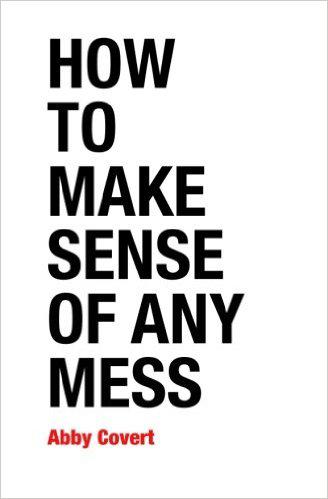How to Make Sense of Any Mess
My notes from How to Make Sense of Any Mess

by Abby Covert How to Make Sense of Any Mess: Information Architecture for Everybody
Citation (APA): Covert, A. (2014). How to Make Sense of Any Mess: Information Architecture for Everybody [Kindle iOS version]. Retrieved from Amazon.com
1.Identify the Mess
Practicing information architecture means exhibiting the courage to push past the edges of your current reality. It means asking questions that inspire change. It takes honesty and confidence in other people.
What if turning on the light reveals that the room is full of scary trolls? What if the light reveals the room is actually empty? Worse yet, what if turning on the light makes us realize we've been living in darkness?
To help Carl identify his mess, we could start by asking questions about its edges and depths: Who are his users and what does he know about them already? How could he find out more? Who are the stakeholders and what does he know about what they are expecting? How does he want people to interpret the work? What content would help that interpretation? What might distract from that interpretation?
it's important to identify the edges and depths of a mess, so you can lessen your anxiety and make progress.
To start to identify the mess you're facing, work through these questions: Users: Who are your intended users? What do you know about them? How can you get to know them better? How might they describe this mess? Stakeholders: Who are your stakeholders? What are their expectations? What are their thoughts about this mess? How might they describe it? Information: What interpretations are you dealing with? What information is being created through a lack of data or content? Current state: Are you dealing with too much information, not enough information, not the right information, or a combination of these?
2. State your Intent
If we're going to sort out the messes around us, we need to ask difficult questions and go deeper than how something looks to determine if it's good or not.
To start with why, ask yourself: Why does this work need to be done? Why is change needed? Why do those changes matter? Why should other people care? Why hasn't this been tackled correctly? Why will this time be different?
How long would you spend on a task without understanding why it's important or what you are actually accomplishing? Constantly answering these basic questions are a big part of our everyday life.
3. Face Reality
As you go through the mess, you'll encounter several types of players: Current users: People who interact with whatever you're making. Potential users: People you hope to reach. Stakeholders: People who care about the outcome of what you're making. Competitors: People who share your current or potential users. Distractors: People that could take attention away from your intent.
4. Choose a Direction
Once you know what level you're working at, you can zoom in to the appropriate level of detail. Sometimes we need to zoom all the way in on an object. Other times it's more important to zoom out to look at the ecosystem. Being able to zoom in and out as you work is the key to seeing how these levels affect one another.
5. Measure the Distance
Common indicators. Satisfaction: Are customers happy with what you're delivering against your promises? Kudos: How often do people praise you for your efforts or contributions? Profit: How much was left over after expenses? Value: What would someone pay for it? Loyalty: How likely are your users to return? Traffic: How many people used, visited, or saw what you made? Conversion: What percentage of people acted the way you hoped they would? Spread: How fast is word getting around about what you're doing? Perception: What do people believe about what you're making or trying to achieve? Competition: Who has similar intents to yours? Complaints: How many users are reaching out about an aspect of your product or service? Backlash: What negative commentary do you receive or expect? Expenses: How much did you spend? Debt: How much do you owe? Lost time: How many minutes, hours, or days did you spend unnecessarily? Drop-off: How many people leave without taking the action you hoped they would? Waste: How much do you discard, measured in materials and time? Murk: What alternative truths or opinions exist about what you're making or trying to achieve?
6. Play with Structure
Assess the content and facets that are useful for what you're trying to convey.
7. Prepare to Adjust
Messes only grow with time. You can easily make excuses and hold off on doing something until the conditions are right, or things seem stable.
It's totally normal for fear, anxiety, and linguistic insecurity to get in the way of progress. Learning to work with others while they're experiencing these not-so-pleasant realities is the hardest part of making sense of a mess.
An important part of that is identifying the differences between what stakeholders think users need and what users think they need for themselves.
It's hard to find the words for what's wrong.
It's hard to argue with people you work with about fuzzy things like meaning and truth.
It's hard to ask questions. It's hard to hear criticism. It's hard to start over. It's hard to get to good.
Have you explored the depth and edges of the mess that you face? Do you know why you have the intent you have and what it means to how you will solve your problem? Have you faced reality and thought about contexts and channels your users could be in? What language have you chosen to use to clarify your direction? What specific goals and baselines will you measure your progress against? Have you put together various structures and tested them to make sure your intended message comes through to users? Are you prepared to adjust?